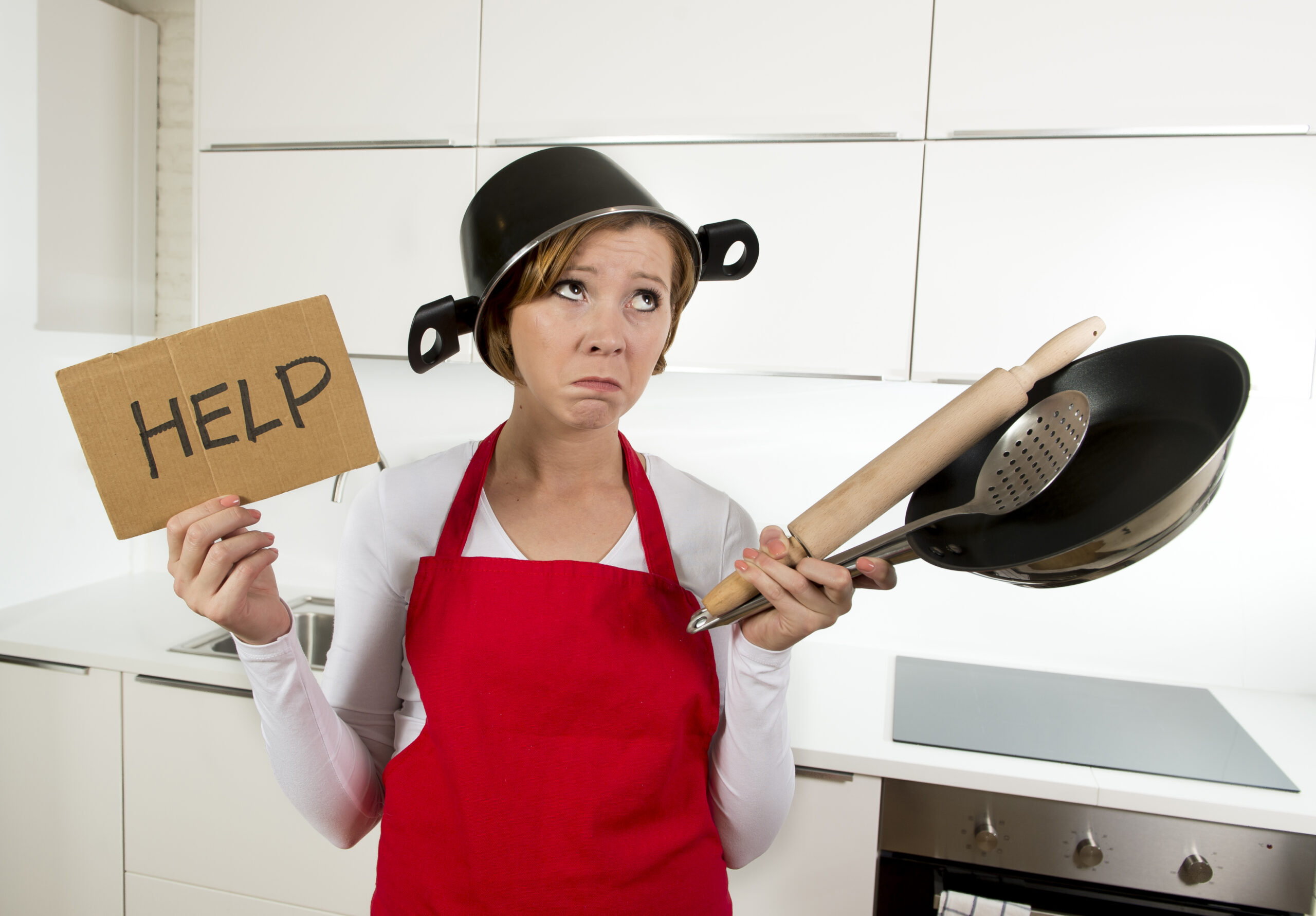Oh, honey, have you been stirring up some kitchen disasters again? Well, pull up a chair, and let’s have a little chat. Today, we’re going to explore the wacky world of cooking mistakes and blunders—you know, those little ‘oops’ moments that have you saying…
Well, that didn’t go as planned. 🙁
We’re diving into a treasure trove of common kitchen mishaps, and I’m going to give you the lowdown on how to sidestep them like a pro. From skimming through recipes faster than a teenager texting (yes, I see you), to grabbing whatever utensil is within arm’s reach (a shoe is not a spatula, dear), and the age-old sin of under-seasoning (it’s not just salt and pepper, you know).
We’re covering all the bases, from A to Zucchini! So, let’s roll up our sleeves, put on our aprons, and embark on a journey to become the kitchen wizards we were always meant to be—and yes, that includes mastering the art of not burning water. Ready? Let’s get cooking, and remember, if at first you don’t succeed, order pizza!”
From not reading the recipe thoroughly to using the wrong tools and forgetting to season properly, we’ve got you covered. So, let’s dive in and become a better cook by avoiding these 12 common mistakes!
The Heat is on, Avoiding Temperature Troubles in the Kitchen
Using the Wrong Cooking Temperature
One of the most common mistakes in the kitchen is using the wrong cooking temperature. Cooking at too high or too low a temperature can greatly affect the outcome of your dish. For example, if you cook meat at too high a temperature, it can become tough and dry.
On the other hand, cooking at too low a temperature can result in undercooked or raw food. It’s important to follow recipes closely and use the recommended cooking temperature to ensure success in the kitchen.
More cooking mistakes – heat sources
Another temperature-related mistake is misunderstanding heat sources. Different cooking methods require different heat sources, such as stovetop burners, ovens, grills, or even microwaves.
Each heat source has its own unique characteristics and optimum temperature range. It’s crucial to familiarize yourself with the heat sources you have in your kitchen and understand how to use them properly. This will help you achieve the desired results in your cooking and avoid any temperature-related troubles.
Measure for Measure: The Perils of Eyeballing Ingredients
Importance of Accurate Measurements
When it comes to cooking, accurate measurements are key. Eyeballing ingredients may seem convenient, but it can lead to inconsistent results.
Too much or too little of an ingredient can completely throw off the balance of flavors and textures in a dish. By using precise measurements, you can ensure that your dishes turn out as intended. Invest in measuring cups, spoons, and a kitchen scale to help you achieve accurate measurements and improved cooking results.
Common Ingredient Substitutions
Sometimes, you may find yourself missing a specific ingredient for a recipe. While substitutions can be handy, it’s important to understand the impact they can have on the final dish.
Different ingredients have different flavors, textures, and moisture content, which can affect the overall taste and consistency of your recipe. Before making a substitution, do your research and find suitable alternatives that will still yield a desirable outcome. It’s always better to stick to the original recipe if possible, to ensure the best results.
Timing is Everything: Common Timing Mistakes and How to Fix Them
Overcooking or Undercooking
Timing plays a crucial role in the kitchen. Overcooking or undercooking your food can greatly impact its taste and texture. Whether it’s meat, vegetables, or baked goods, it’s important to keep a close eye on the cooking time specified in the recipe.
Use timers and regularly check the doneness of your food to avoid any timing mishaps. Remember, it’s always better to slightly undercook your food and let it rest than to overcook it and end up with a dry or burnt result.
Not Allowing Enough Time for Resting
Resting is an essential step in the cooking process that is often overlooked. After removing the meat from the heat source, it’s important to allow it to rest for a few minutes before cutting into it. Resting allows the juices to redistribute throughout the meat, resulting in a more flavorful and tender end product.
Similarly, baked goods also benefit from resting, as it allows them to set and develop their desired texture. Always factor in resting time when planning your cooking schedule for optimal results.
Not Factoring in Carry-over Cooking
Carry-over cooking is a phenomenon where the residual heat continues to cook the food even after it has been removed from the heat source. This is particularly important to note when cooking meat, as the internal temperature will continue to rise for a few minutes after it has been taken off the heat.
To ensure perfectly cooked meat, it is recommended to remove it from the heat source a few degrees below the desired doneness. The residual heat will then bring it to the perfect temperature while it rests.
More tips to avoid cooking mistakes
Mix and Match Mishaps: The Art of Proper Ingredient Pairing
Pairing Complementary Flavors
Pairing complementary flavors is an art that can elevate the taste of your dishes. By choosing ingredients that enhance and balance each other, you can create harmonious flavor profiles.
For example, pairing sweet and acidic ingredients can add brightness to a dish, while combining savory and umami-rich ingredients can create depth of flavor.
Experiment with different flavor combinations and learn how they interact with each other to create well-balanced and delicious meals.
Avoiding Clashing Flavors
While pairing complementary flavors is important, it is equally crucial to avoid clashing flavors. Certain ingredients may not work well together, resulting in an unpleasant taste experience. For example, combining strong spices with delicate flavors can overpower the dish and mask the intended flavors.
When experimenting with new recipes or flavor combinations, start with small amounts and taste as you go. This will allow you to adjust and balance the flavors to create a cohesive and enjoyable dish.
Utensil Underuse: Choosing the Right Tools for Every Task
Using the Wrong Knife for Cutting
Using the wrong knife for cutting can make the task more difficult and can also affect the final presentation of your food. Different knives are designed for specific purposes, such as slicing, dicing, or chopping.
Using the appropriate knife for each task can make food preparation easier, safer, and more efficient. Invest in a quality set of knives and learn how to properly use and care for them. This will not only enhance your cooking experience but also ensure that you achieve clean and precise cuts.
Using the Wrong Pan for Cooking
Just like knives, different pans are designed for different cooking methods. Using the wrong pan can lead to uneven heat distribution, burning, or sticking of your food. For example, nonstick pans are great for cooking delicate items that are prone to sticking, while cast iron pans are perfect for achieving a deep sear and even heat distribution.
Take the time to understand the characteristics of different pans and choose the right one for each cooking task. This will help you achieve better cooking results and avoid unnecessary frustration.
Seasoning Slip-ups: Finding the Balance Between Bland and Overwhelming
Underseasoning
Underseasoning is a common mistake that can result in dull and bland-tasting food. Seasoning is crucial in enhancing the flavors of your dishes and bringing them to life.
Salt is not the only seasoning to consider; spices, herbs, and other flavor enhancers should also be used in proper proportions. Taste your dish as you go and adjust the seasoning accordingly. It’s better to start with a conservative amount and gradually add more, rather than ending up with an overseasoned dish.
Overseasoning
On the other end of the spectrum, overseasoning can overwhelm the taste buds and ruin a dish. It’s important to strike a balance and allow the natural flavors of the ingredients to shine through.
If you find that you’ve added too much seasoning, try diluting the dish with additional unsalted ingredients or adjusting the other components of the dish to balance out the flavors. Remember, it’s always easier to add more seasoning than to tone it down once it’s already too strong.
Not Adjusting Seasoning Throughout Cooking
Seasoning is not a one-time step; it should be adjusted and tasted throughout the cooking process. As ingredients cook and flavors develop, the need for additional seasoning may arise. Taste your dish at different stages and make adjustments as necessary.
This will ensure that the flavors are well-balanced and that your final dish is seasoned to perfection.
Remember, cooking is a journey of continuous learning and improvement. By avoiding these common mistakes and practicing good kitchen habits, you can become a better cook and enjoy more successful culinary adventures in your own kitchen. Happy cooking!
Happy Cooking!


